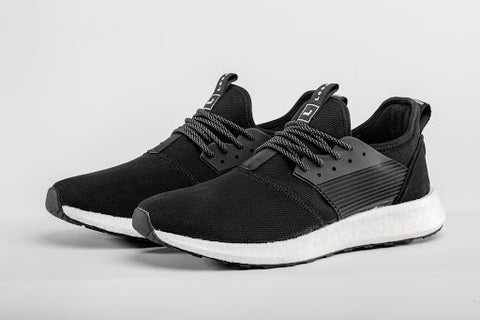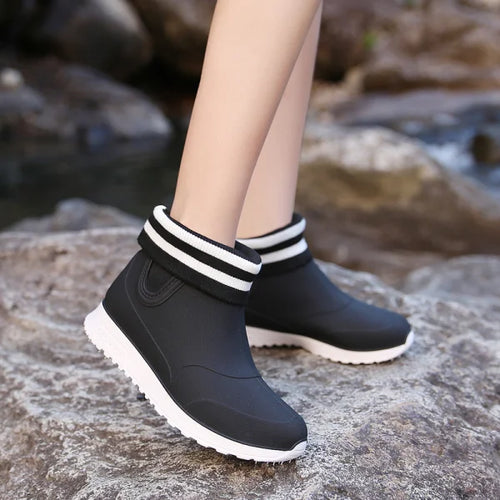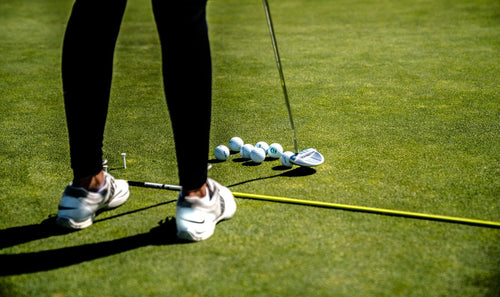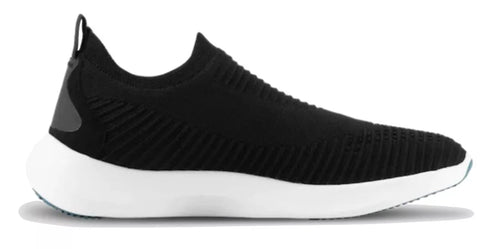In everyday vernacular, it’s pretty common for people to switch out one word for another- and usually, they can get away with it.
But when it comes to footwear, there is a world of difference between “waterproof” and “water-resistant.” So, while water-resistant and waterproof running shoes might sound similar to you, they’re really not. And the difference goes beyond the name.
So before you go around using those two terms interchangeably, read this article to understand why you might be wrong to do so.
What Are Waterproof Shoes
Waterproof shoes are specialized footwear designed to completely block out water, ensuring your feet stay dry even in the wettest conditions.
Manufacturers construct these shoes using advanced materials such as waterproof membranes, sealed seams, and waterproof coatings, all working together to prevent water from entering the shoe.
These shoes serve multiple purposes, including:
- Preventing water from soaking into the shoes
- Keeping your feet dry from external moisture
- Protecting against snow
- Keeping your feet warm in winter
Waterproof footwear is essential for outdoor enthusiasts, workers in wet environments, and anyone needing reliable protection against water.
When companies market their shoes as waterproof, they give you the green light to trek in the rain, wading through streams, or brave snowy conditions—all without worrying about wet feet and mushy shoes.
The most classic example of waterproof footwear is the rain boot. Made from rubber and designed with a snug, shin-high fit, these boots remain completely dry as water rolls off their surface.
Traditionally, waterproofing was reserved for boots, particularly hiking and snow boots, still considered the highest tier of waterproof footwear.
However, technological advancements have expanded the range of waterproof options, including athletic gear like waterproof running shoes. These innovations mean you no longer have to choose between performance and protection, allowing you to stay active in wet conditions without compromising comfort or dry feet.
What Are Water-Resistant Shoes
On the other side of the spectrum, we have water-resistant shoes. Water-resistant footwear is ideally designed to repel water to a certain extent, providing moderate protection against moisture.
Manufacturers typically use treated leather or coated fabrics to make these shoes, ensuring they resist water penetration.
While they can handle light rain or brief splashes, they are not fully waterproof, meaning that with prolonged exposure, water may eventually seep through. This is why they can quickly become heavily saturated, especially when submerged in water or worn in heavy downpours.
Water-resistant footwear suits everyday wear in mildly wet conditions, balancing comfort, breathability, and essential water protection.

On the other side of the spectrum, we have water-resistant shoes. Water-resistant footwear is ideally designed to repel water to a certain extent, providing moderate protection against moisture.
Manufacturers typically use treated leather or coated fabrics to make these shoes, ensuring they resist water penetration.
While they can handle light rain or brief splashes, they are not fully waterproof, meaning that with prolonged exposure, water may eventually seep through. This is why they can quickly become heavily saturated, especially when submerged in water or worn in heavy downpours.
Water-resistant footwear suits everyday wear in mildly wet conditions, balancing comfort, breathability, and essential water protection.
These shoes can:
- Lessen water penetration to a small extent
- Keep your feet dry from internal moisture
- Keep your feet cool in the summers
Key Differences Between Waterproof and Water-Resistant Shoes
If you’re still unable to discern the difference between water-resistant and waterproof running shoes, then a different approach might help.
Let us look into the key differences between waterproof and water-resistant shoes.
|
Criteria |
Waterproof shoes |
Water-resistant shoes |
|
Definition |
Completely block water from entering, designed for full protection in wet conditions. |
Offer limited protection by repelling water to a certain extent, but not entirely impermeable. |
|
Usage Context |
Ideal for heavy rain, snow, hiking in wet environments, and situations where feet may be submerged. |
Suitable for light rain, occasional splashes, and environments with minimal water exposure. |
|
Material |
Often made with materials like Gore-Tex, eVent, and other waterproof membranes that create a barrier against water. |
Made from treated leather, coated fabrics, and other materials that resist water but do not fully block it. |
|
Construction Technique |
Incorporate techniques like seam sealing, waterproof zippers, and fully waterproof linings to ensure no water penetration. |
Use construction methods that may slow water entry but do not seal it completely; seams and zippers may be less protected. |
|
Breathability |
Tend to be less breathable due to the waterproof barrier, but advanced technologies like Gore-Tex aim to balance waterproofing with breathability. |
Generally more breathable than waterproof shoes because they lack a full waterproof membrane. |
The IP Rating System
Earlier, we said that water-resistant shoes are “on the other end of the spectrum.” But this was more than just a figure of speech.
Water-resistant shoes are on the lower end of the waterproofing spectrum, and this difference is quantified by the Ingress Protection (IP) rating system.
This system assigns footwear an IPX rating from 0 to 8, with higher numbers indicating more outstanding waterproof capabilities. A shoe with an IPX8 rating is completely waterproof, while a shoe with an IPX0 rating offers no waterproof protection.
"Waterproof" shoes generally have an IP rating of 6 or higher, meaning they're highly resistant to water. In contrast, "water-resistant" shoes have a rating below 4, offering less protection.
The IP rating is the most reliable way to gauge a shoe's water resistance, but finding this information is often challenging. It's essential to check the IP rating, especially for shoes marketed as waterproof, to ensure they meet your needs.
There's a third category between waterproof and water-resistant: water-repellent shoes, which offer moderate water resistance. Next time you select footwear, think of the IP scale to understand the level of water protection you're getting.
What Makes Waterproof Running Shoes Resistant to Water
Let's explore the specific materials, construction techniques, and how these elements work together to create effective waterproof footwear.
Material Specifications
The effectiveness of waterproof running shoes largely depends on the materials used, with Gore-Tex being one of the most renowned.
Gore-Tex is a microporous membrane made from expanded polytetrafluoroethylene (ePTFE). This membrane contains over 9 billion pores per square inch, each small enough to block water droplets while allowing moisture vapor from sweat to escape.
This dual functionality makes Gore-Tex a favorite in waterproof footwear, as it ensures both waterproofing and breathability.
Another material used is eVent, which operates similarly to Gore-Tex but features a direct venting technology. Unlike Gore-Tex, which requires moisture vapor to build up before it escapes, eVent allows sweat to pass through immediately, enhancing breathability.
Materials like treated leather and coated synthetic fabrics are common in water-resistant shoes. These materials are treated with water-repellent chemicals like DWR (Durable Water Repellent), which causes water to bead and roll off rather than soak in. However, these treatments are temporary and can wear off over time, reducing the shoe's effectiveness.
Construction Techniques
Designers meticulously enhance water resistance in waterproof running shoes through careful construction. One critical method involves sealing all the seams with waterproof tape to prevent water from seeping through the stitching holes.
Manufacturers often include gusseted tongues in waterproof shoes. They connect the tongue to the shoe's upper on both sides, blocking water from entering the lace area.
In designs requiring zippers, manufacturers incorporate waterproof zippers to protect these potential entry points.
These construction techniques maintain the waterproof qualities of the materials, avoiding compromises caused by poor design or manufacturing.
Breathability
A significant challenge with waterproof shoes is maintaining breathability, as the same properties that keep water out can also trap moisture.
Gore-Tex addresses this with its microporous structure, allowing sweat to escape while preventing water from entering. This is crucial for runners, as trapped moisture can lead to discomfort and blisters.
eVent, with its direct venting technology, offers even greater breathability, making it a strong competitor to Gore-Tex, especially in high-intensity activities where managing sweat is critical.
In water-resistant shoes, breathability is generally better because they lack the impermeable membranes found in waterproof shoes. However, this comes at the cost of reduced protection against heavy moisture.
Factors That Enhance Water Resistance in Running Shoes
While the type of material used is vital in determining its resistance to water, other factors also contribute greatly.
Now, all of the factors don't need to be included in waterproof footwear. A shoe can have one, all, none, or a combination of all these different factors.
Of course, the more characteristics they have, the more the IP scale will tip towards the right. Here are the most common factors that enhance water resistance in running shoes.
1. Seam Sealing
Seam sealing is a critical construction technique that involves sealing the seams of the shoe with waterproof tape. This prevents water from seeping through the tiny holes created by stitching, ensuring that the shoe remains watertight even in wet conditions.
2. The Upper
The upper, which is the outer layer of the shoe, excluding the sole, plays a significant role in water resistance. Many waterproof running shoes, such as Loom Footwear, feature breathable mesh or knit materials for the upper, often combined with advanced materials like Gore-Tex.
3. The Inner Membrane
Inside the shoe, some models include a waterproof inner membrane lining. This membrane is not only effective at blocking water but is also breathable, helping to keep your feet cool and dry, particularly in hot and humid conditions where sweat can be an issue.
4. The Outsole
The outsole is just as important as the upper in waterproof running shoes. Flexible rubber soles are commonly used because they prevent water from entering the shoe while providing excellent grip on wet or icy surfaces, which is essential for maintaining stability and safety.
5. Design Elements
Various design elements contribute to a shoe's water resistance. Choices such as whether the shoe has laces or is laceless, the height of the ankle, and whether the shoe is stitched or knitted all affect how well the shoe can keep water out.
6. Chemical Treatment
Some manufacturers enhance the water resistance of their shoes by applying external water-repellent sprays. These treatments cause water to bead up and roll off the surface of the shoe, adding an extra layer of protection against moisture.
Waterproof, Worry-Free: Loom Shoes Keep You Moving Comfortably in Any Weather.
Also read: Best Lightweight Flexible Shoes For Your Feet and Posture
Waterproof Shoes Vs Water-Resistantfully waterproof
By now, you already know that water-resistant shoes are less impervious to water than waterproof shoes. But the differences don’t just end there.
Let’s take a look at some of the most salient distinctions between waterproof and water-resistant shoes.
IP Rating
We have already talked about the IP rating in detail. But just to formalize things, allow us to reiterate.
Shoes that have a “waterproof” label on them have a high IP rating, usually greater than 6. This high IP rating means that the shoes are extremely impervious to water. Contrastingly, water-resistant shoes have a low IP rating, usually less than 4.
The IP rating is the most reliable way to determine a shoe’s waterproof capabilities. Unfortunately, it's not always easy to find the IP rating for footwear. You might have to dig deep to determine where the shoe stands along the IP scale.
Checking the IP rating is extremely important, especially for shoes that claim to be 100% waterproof. If the shoe is marketed as “waterproof” but has a low IP score, you might want to think twice before buying it.
Materials
These days, there’s virtually no limit to the material used in waterproof shoes. Almost any material can be modified for water resistance.

However, you’ll find that waterproof footwear is often made from rubber, neoprene, vinyl, nylon, or polyurethane. But their athletic counterparts, such as waterproof running shoes, use vastly different materials simply out of necessity. These materials are more flexible and breathable than those used in the archetypal water-resistant boot.
In contrast, water-resistant shoes use materials such as leather, suede, or nylon. These materials are naturally water-resistant, but only to a certain extent.
Breathability
Generally, shoes that are fully waterproof are less breathable. The poor ventilation is an unavoidable consequence of the hard-packed, non-porous upper material.
Some shoe designs, especially for waterproof running shoes, have ventilation along the sides of the shoe. Manufacturers install actual vents in the shoes to allow the exchange of air while keeping the water and dust out.
Additionally, you’ll find that a lot of athletic waterproof footwear uses GoreTex technology. As discussed previously, GoreTex is a waterproof membrane that has a high breathability factor.
Apart from the exceptions mentioned above, however, waterproof footwear is generally less breathable.
On the other hand, water-resistant shoes have better ventilation thanks to the porous materials, making them perfect for those peak summer days.
Flexibility
Generally, waterproof footwear is less flexible since it uses rigid materials and stiff soles.

Once again, however, high-end waterproof running shoes are an exception to this rule. This is because running shoes have to be flexible to allow for rapid and dynamic foot movement.
Contrastingly, water-resistant shoes are noticeably more flexible owing to the type of material used in their construction. This combination of flexibility and breathability makes waterproof shoes more comfortable.
However, keep in mind that these are general observations; not all water-resistant footwear is comfortable, breathable, and flexible. Similarly, not all waterproof footwear is stiff, warm, and stuffy.
Price Point
Compared to regular footwear, waterproof, water-resistant, and water repellent shoes are noticeably more expensive. This is because they use a variety of waterproof technologies that are costlier to manufacture.
However, the differences in the price point between waterproof and water-resistant shoes are difficult to discuss- at least in such few words. But if we had to sum it up, we would assert that there isn’t a noticeable or consistent difference between the two types of shoes' prices.
The inconsistency of prices is primarily because companies often mislabel their footwear. This mislabelling could, in turn, be because of discrepancies in the definitions of waterproof and water-resistant, combined with rapidly advancing footwear technology.
Can Shoes Really Be 100% Waterproof?
Let’s say that a waterproof running shoe bags an IP score of IPX8- the highest level of water resistance. Does this mean that the shoe is 100% waterproof?
Unfortunately, no shoe can ever be totally waterproof- not even IPX8-rated ones.
No matter how waterproof a shoe is, there is always a chance that some moisture can seep through. There can be multiple reasons for this.
Apart from leather, rubber, and plastic shoes, all other materials will eventually succumb to water. For example, most waterproof running shoes are made from flexible materials that are at least a little bit porous by nature.
Now, manufacturers often use chemical treatments and other external treatments to increase the shoe’s resistance to water. However, these treatments, as well as the shoe material, can lose their integrity over time.
Additionally, many shoe companies will market their shoes as waterproof when they’re really water-resistant. While the intentions are not always malicious, this practice is still very misleading and might be the reason your new waterproof running shoes may not live up to your expectations.
So, the only way to guarantee 100% waterproof-ness is by using an overshoe or securing a plastic wrap around your shoes.
Water Resistant or Waterproof Running Shoes-Which Is Better?
At this point, you might be wondering which is better: waterproof or water-resistant shoes. The answer isn't straightforward, as each has its own pros and cons. The best choice depends on your specific needs and environment.

For example, a water-resistant shoe is your best bet if you're looking for athletic shoes to optimize your gym sessions. It offers greater flexibility, excellent lateral stability, and breathability while protecting against unexpected splashes or spills.
Similarly, a fully waterproof boot is recommended if you need a winter boot for trudging through snow. It will keep your feet dry and warm in harsh, wet winter conditions.
Similarly, if you go trekking during the rainy season, you'll need waterproof boots to keep your feet dry on wet, muddy trails. These boots are essential for protecting against heavy rainfall and waterlogged paths.
However, water-resistant shoes might be more suitable if you're hiking in drier conditions where the ground is only slightly damp. They offer enough protection to keep your feet comfortable without the bulk of waterproofing, making them an excellent choice for less extreme environments.
If you're an industrial worker in a hot climate, you need waterproof and breathable footwear. Standard waterproof running shoes may not provide sufficient protection or breathability. Instead, you should look for work boots with a breathable, waterproof membrane to keep your feet dry without overheating.
Ultimately, understanding your specific needs will help you choose the right type of shoe, whether it's for athletic performance, winter conditions, or workplace safety. With this knowledge, you can make a well-informed purchase.
Conclusion
On the surface, the terms “waterproof” and “water-resistant” might sound similar- almost analogous. But as we saw, there are just too many differences between the two to ignore.
Of course, the most apparent difference is that waterproof shoes have a much higher IP rating than water-resistant shoes. In other words, waterproof shoes do a better job at keeping the moisture out.
However, water-resistant shoes are generally more comfortable to wear; what they lack in impermeability, they make up for in breathability and flexibility.
At the end of the day, however, one is not automatically better than the other. Instead, it all depends on you. So ask yourself this: what are your footwear needs?
Loom's 100% Waterproof Design: Your Ultimate Companion for Rainy Days and Beyond.



























